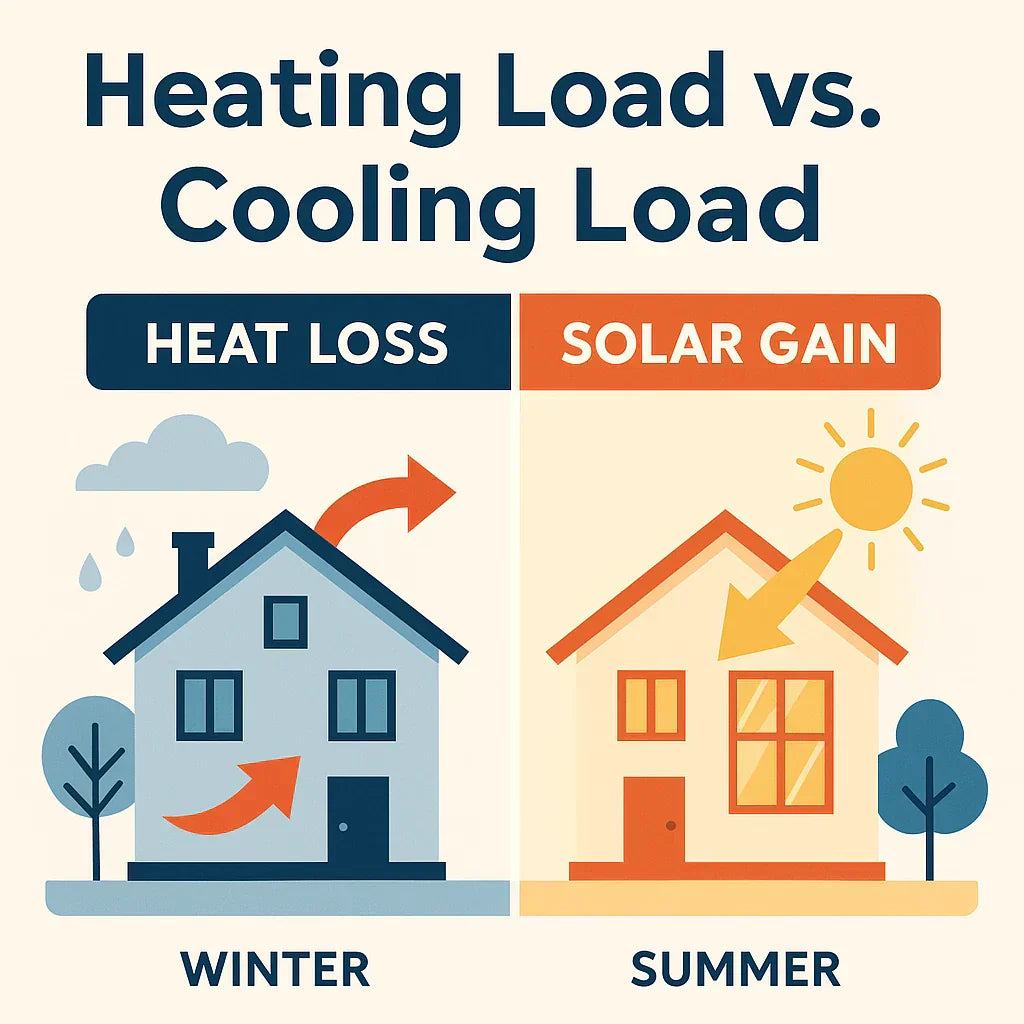Most homeowners assume that one HVAC size works for both heating and cooling. After all, your furnace and air conditioner (or heat pump) share the same ducts—so why wouldn’t the sizing be the same?
Here’s the catch: heating and cooling loads aren’t always equal. Depending on your home’s design, insulation, and climate, your house may need more capacity for winter heating or summer cooling.
The right HVAC system isn’t about choosing a size for one season—it’s about balancing performance year-round. Let’s break down how heating and cooling loads differ, what happens when sizing favors one side too heavily, and how pros find the right balance.
For the basics of sizing any system, start with the main guide: How to Size an HVAC System for Your Home.
The Basics of HVAC Sizing
Sizing isn’t guesswork—it’s a calculation. Professionals use Manual J load calculations to determine how much heating and cooling capacity a home needs.
This process factors in:
-
Square footage and ceiling height
-
Insulation levels
-
Window area and type
-
Orientation of the home (north, south, etc.)
-
Local climate data
The U.S. Department of Energy emphasizes that square footage alone is not enough. Two homes of the same size can have very different heating and cooling demands based on insulation, air sealing, and solar exposure.
Why Heating and Cooling Loads Differ
Climate and Geography
Where you live plays a huge role. In northern states, winters are long and cold, so heating loads dominate. In the south, hot and humid summers mean cooling needs are much higher.
The IWAE climate zone guide explains that HVAC sizing must reflect the balance of heating and cooling demands in your region. A Minnesota home may be sized primarily for heating, while a Florida home must prioritize cooling.
The Home Envelope and Insulation
Your home’s envelope—insulation, air sealing, windows, and doors—affects heating and cooling differently.
-
Winter: Heat escapes through walls, attics, and poorly sealed windows.
-
Summer: Sunlight streaming through glass (solar gain) increases cooling loads.
The DOE’s air sealing guidance explains that sealing gaps and improving insulation can significantly cut heating and cooling demand. In colder climates, these upgrades often reduce winter heating loads more dramatically.
Occupant Behavior
Lifestyle adds another layer. Cooking, electronics, and occupancy contribute more to cooling demand than heating. Add in humidity, and summer loads often feel more intense—even if the raw temperature difference isn’t as large.
What Happens If Your HVAC Size Favors Only One Season?
Oversized for Cooling
An air conditioner that’s too big will cool the air quickly but won’t run long enough to remove humidity. The result? Clammy, sticky air even when the thermostat says it’s “comfortable.”
The ASHRAE comfort standards highlight humidity control as a critical factor in indoor comfort and health. Oversized cooling systems fail at this, often leaving homeowners with mold and indoor air quality concerns.
Undersized for Heating
A furnace or heat pump that’s too small will run almost nonstop in winter. You may end up with cold spots, higher energy bills, and even risks like frozen pipes during extreme cold.
The DOE’s guide to estimating heating efficiency and costs emphasizes that heating systems must be correctly sized and efficient to operate safely and cost-effectively. An undersized system strains constantly, reducing efficiency and reliability when you need it most.
How Professionals Balance Heating vs. Cooling Needs
Manual J and Local Climate Data
Contractors don’t size your system for just one extreme day. They use climate data to balance heating and cooling needs. In hot-humid regions, cooling usually takes priority; in cold climates, heating load drives the decision.
The Role of Heat Pumps
Heat pumps add a unique twist since they provide both heating and cooling. They must be carefully sized to handle summer cooling loads while still delivering enough heat in winter.
The ENERGY STAR heat pump guide recommends selecting models designed for your region’s climate zone to avoid undersizing in winter or oversizing in summer.
Supplemental or Dual-Fuel Systems
Sometimes, one unit can’t efficiently handle both extremes. That’s why dual-fuel systems (a heat pump paired with a gas furnace) or supplemental heating may be smarter than oversizing one system. This approach keeps efficiency high while ensuring comfort in all seasons.
Best Practices for Homeowners
Here’s what you can do to ensure your HVAC system is sized properly for both heating and cooling:
-
Always request a Manual J calculation. Don’t settle for rule-of-thumb sizing.
-
Ask how your local climate affects load balance. Heating-dominated vs. cooling-dominated regions require different strategies.
-
Check your ductwork. Even the best-sized system won’t work if ducts are undersized or leaky.
-
Upgrade insulation before sizing. A better envelope means you may need a smaller system overall.
-
Consider zoning. In multi-story homes, zoning helps balance heating and cooling demands more precisely.
For more on how your home’s design affects HVAC needs, see: How Solar Gain and Shade Affect HVAC Sizing.
Final Thoughts
So, do you need different HVAC sizes for heating and cooling? Not two separate systems—but the answer is that heating and cooling loads are rarely equal.
The best solution is a balanced system sized for your home’s year-round needs. That means:
-
Manual J calculations, not guesswork.
-
Factoring in climate, insulation, and lifestyle.
-
Considering options like heat pumps, dual-fuel systems, or zoning.
When efficiency and comfort are on the line, a “one-size-fits-all” approach doesn’t cut it. The right size is the one that keeps your home comfortable, safe, and efficient in every season.
Alex Lane
Your Home Comfort Advocate







